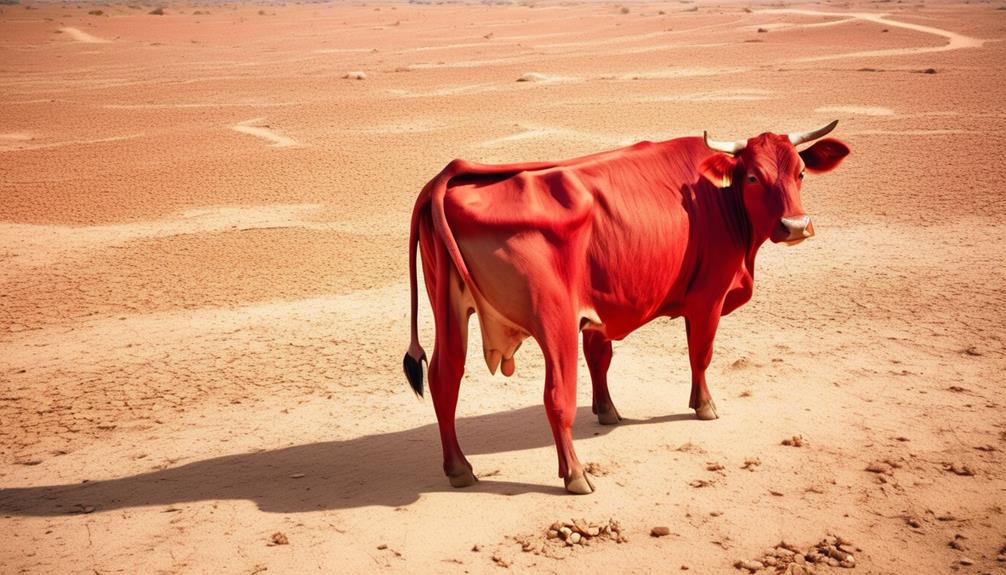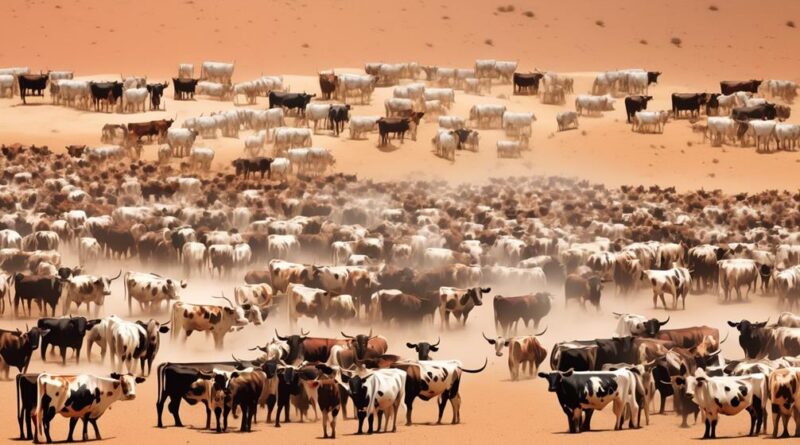Top Climate-Adapted Cattle Breeds for Hot Environments
Are you struggling to find the perfect cattle breeds that can thrive in scorching hot environments? Look no further, as there are several top climate-adapted cattle breeds specifically tailored to endure and even flourish in such challenging conditions.
These breeds have been meticulously developed and selected over time to withstand intense heat and maintain productivity in arid climates.
As you navigate the vast array of cattle breeds, it's crucial to understand the unique characteristics and abilities that make these specific breeds stand out in hot environments.
Brahman
The Brahman is a highly adaptable breed of cattle known for its genetic heat tolerance and resilience in challenging climates. This breed has a remarkable ability to thrive in hot and humid conditions, making it a valuable asset for farmers in tropical and subtropical regions. The Brahman's genetic heat tolerance is a result of natural selection, where only the most heat-tolerant individuals survived and passed on their resilient genes. As a result, Brahman cattle have evolved to efficiently regulate their body temperature, making them well-suited for withstanding high temperatures.
In hot climates, the Brahman's impact on crossbreeding has been significant. When crossed with other breeds, the Brahman's genetic traits for heat tolerance are often passed on to the offspring, resulting in hybrid cattle that exhibit increased heat tolerance and overall hardiness. This has led to the development of new breeds that are better adapted to hot and challenging environments, ultimately improving the overall productivity and welfare of cattle in these regions.
Whether it's their distinctive hump, droopy ears, or loose skin, Brahman cattle stand out for their ability to thrive in harsh conditions. Their impact on crossbreeding in hot climates has been transformative, contributing to the development of breeds that can better withstand the challenges posed by high temperatures. This adaptability and resilience make the Brahman a breed of choice for farmers looking to raise cattle in hot and challenging climates.
Senepol
Originating from the Caribbean, Senepol cattle boast exceptional heat tolerance and adaptability, making them a sought-after breed for tropical and subtropical regions. Senepol breeding techniques are crucial in developing their heat tolerance. Through selective breeding, the Senepol breed has been refined to thrive in hot climates, making them an ideal choice for regions with high temperatures and humidity. This has led to the development of a breed that isn't only heat-tolerant but also resilient and well-adapted to challenging environmental conditions.
Senepol meat quality is another remarkable aspect of this breed. The meat of the Senepol cattle is renowned for its exceptional tenderness and flavor. The high meat quality is a result of the breed's genetic characteristics and its ability to efficiently convert forage into high-quality beef. Senepol cattle are known for producing well-marbled, tender, and flavorful meat, which is highly desirable in the beef industry.
Senepol breeding techniques are vital for developing the breed's heat tolerance.
The meat of Senepol cattle is renowned for its exceptional tenderness and flavor.
Senepol cattle are well-adapted to challenging environmental conditions, making them ideal for hot climates.
N'Dama
Developing heat tolerance in cattle breeds is essential. Now, let's examine the unique characteristics of N'Dama cattle. N'Dama cattle are renowned for their exceptional heat tolerance and genetic adaptation to hot environments. Originating from West Africa, these cattle have evolved to thrive in regions with high temperatures and scarce water sources. Their ability to maintain productivity in such challenging conditions makes them a valuable breed for areas prone to heat stress.
N'Dama cattle possess several physical and genetic traits that contribute to their heat tolerance. They have a unique coat coloration which helps in reflecting sunlight, reducing heat absorption, and minimizing the risk of heat-induced stress. Additionally, their efficient sweating mechanism allows for effective thermoregulation, enabling them to dissipate heat and maintain stable body temperatures even in extremely hot climates.
Genetic adaptation plays a crucial role in the heat tolerance of N'Dama cattle. Through natural selection and centuries of exposure to hot environments, these cattle have developed genetic traits that enhance their ability to cope with heat stress. Their genetic makeup enables them to efficiently utilize available resources, such as forage and water, to support their physiological needs in challenging conditions.
Tuli
Tuli cattle exhibit remarkable heat tolerance and are recognized for their adaptability to hot climates and limited water availability. These cattle have become increasingly important in regions facing environmental challenges due to climate change. Here are some key points to consider:
- Heat Tolerance: Tuli cattle are well-known for their ability to thrive in hot climates. Their heat tolerance makes them a valuable asset in regions with high temperatures, as they can maintain productivity even in such conditions.
- Economic Importance: Tuli cattle play a significant role in the agricultural economy of areas where heat stress is a concern. Their ability to withstand extreme heat allows them to continue providing essential resources such as meat and milk, contributing to the economic stability of these regions.
- Breeding Programs and Genetic Diversity: Due to their valuable traits, Tuli cattle have been the focus of breeding programs aimed at enhancing heat tolerance and other desirable characteristics. These programs have helped to preserve and improve the genetic diversity of Tuli cattle, ensuring their continued resilience in the face of environmental challenges.
Romosinuano
Romosinuano cattle demonstrate exceptional resilience in hot climates and offer valuable genetic traits for sustainable livestock production. Originating from the hot and humid regions of Colombia, Romosinuano cattle are renowned for their remarkable heat tolerance and adaptability traits. These cattle have evolved to thrive in challenging environments, making them a top choice for farmers in hot regions worldwide.
Their heat tolerance is evident in their ability to withstand high temperatures and humidity without experiencing heat stress. Romosinuano cattle have a unique coat that helps them regulate body temperature, keeping them cool even in sweltering conditions. Their adaptability traits enable them to efficiently utilize sparse and low-quality forage, making them well-suited for extensive grazing systems in hot environments. Furthermore, they've developed resistance to common cattle parasites and diseases prevalent in tropical climates, reducing the need for medical interventions and making them a low-maintenance breed.
In addition to their physical resilience, Romosinuano cattle are known for their gentle temperament, making them easier to handle and manage. Their calm disposition also contributes to their overall well-being in hot climates, as stress can exacerbate heat-related issues in livestock.
Boran
Boran cattle, known for their exceptional heat tolerance and adaptability, have gained recognition for their valuable genetic traits suited for sustainable livestock production in hot climates. When it comes to Boran cattle breeding techniques, it's essential to prioritize selection for heat tolerance, disease resistance, and overall adaptability to harsh environmental conditions. This breed's ability to thrive in hot climates makes it a valuable asset for livestock farmers in regions with high temperatures and limited resources.
- Heat Tolerance: Boran cattle are renowned for their ability to withstand high temperatures, making them well-suited for hot and arid environments. Through selective breeding, their heat tolerance can be further enhanced, contributing to more resilient herds.
- Disease Resistance: Boran cattle exhibit natural resistance to various diseases prevalent in hot climates, reducing the need for extensive medical interventions. This not only minimizes healthcare costs but also promotes sustainable and eco-friendly livestock farming practices.
- Market Trends: The demand for Boran cattle has been steadily increasing in hot climate regions, as farmers recognize the value of their genetic traits for sustainable livestock production. This growing interest in Boran cattle has led to a rise in market prices and greater investment in breeding programs aimed at further improving the breed's adaptability and productivity.
Boran cattle's resilience and adaptability make them an invaluable resource for sustainable livestock production in hot environments, and their market trends reflect the increasing recognition of their genetic value.
Red Sindhi

Red Sindhi cattle, like the Boran, possess genetic traits that make them well-suited for sustainable livestock production in hot climates. Red Sindhi is an ideal breed for tropical climates due to its adaptability to hot environments. Originating from the Sindh region of Pakistan, these cattle have been bred for their ability to thrive in extreme temperatures and high humidity. Their adaptability to hot and humid conditions makes them an excellent choice for farmers in tropical regions.
One of the most notable features of the Red Sindhi breed is its ability to withstand heat stress. These cattle have adapted to high temperatures, and their heat tolerance is a result of their genetic makeup. Red Sindhi cattle have a sleek and glossy coat that helps in reflecting the sun's heat, keeping them cooler. Additionally, they've developed efficient sweating mechanisms, allowing them to regulate their body temperature effectively. Their heat tolerance also extends to their reproductive capabilities, as they're known for maintaining fertility even in hot climates.
Furthermore, Red Sindhi cattle are known for their disease resistance, making them well-suited for extensive farming systems in tropical environments. Their ability to thrive on low-quality forages further enhances their suitability for hot climates, as they can withstand periods of drought and scarcity of quality feeds. With these unique genetic characteristics, Red Sindhi cattle continue to be a valuable asset for farmers in hot and humid regions, contributing to sustainable livestock production.
Frequently Asked Questions
What Are the Specific Genetic Traits That Make These Cattle Breeds Well-Adapted to Hot Environments?
You'd want to know what specific genetic traits make these cattle breeds well-adapted to hot environments. Genetic adaptation, heat stress resilience, heat tolerance mechanisms, and environmental adaptation are crucial for thriving in such conditions.
Are There Any Special Management Practices or Feeding Requirements for These Cattle Breeds in Hot Climates?
In hot climates, climate-adapted cattle breeds benefit from specific feeding practices and grazing management. Providing ample access to shade, water, and nutrient-rich forage is crucial. Implementing rotational grazing can also help maintain pasture quality.
How Do These Cattle Breeds Compare in Terms of Resistance to Common Hot Climate-Related Diseases?
When comparing the resistance of cattle breeds to hot climate-related diseases, consider management practices for heat stress and breeding for heat tolerance. Evaluating comparative disease resistance will help you select the most suitable breed for your environment.
Are There Any Specific Challenges or Limitations When It Comes to Breeding and Raising These Cattle Breeds in Hot Environments?
When breeding cattle in hot environments, you'll face challenges. Climate management and feeding requirements play a crucial role. Breeding limitations may arise due to the specific needs of climate-adapted cattle breeds, so careful planning is essential.
Can These Cattle Breeds Be Successfully Integrated Into Existing Crossbreeding Programs for Improved Heat Tolerance in Other Cattle Breeds?
Can these cattle breeds be successfully integrated into existing crossbreeding programs for improved heat tolerance in other cattle breeds? Integrating heat tolerant genetics can pose crossbreeding challenges, but it's crucial for adapting to environmental impact.
Conclusion
In conclusion, when it comes to choosing cattle breeds that are well-suited for hot environments, the top climate-adapted options include Brahman, Senepol, N'Dama, Tuli, Romosinuano, Boran, and Red Sindhi.
These breeds have evolved to thrive in hot climates, making them ideal choices for farmers looking to raise cattle in such environments.
Consider these options when selecting cattle breeds for hot regions to ensure the best chance of success and productivity.
